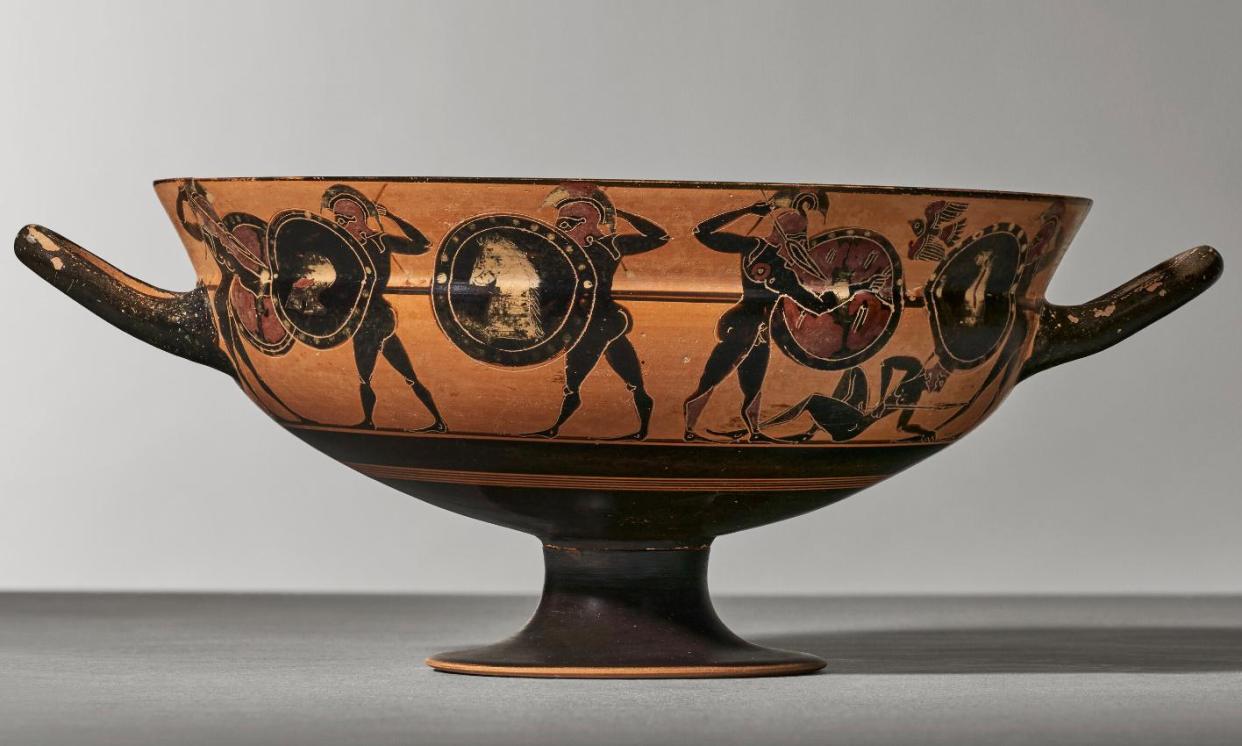Christie’s withdraws Greek vases from auction over links to convicted dealer

Christie’s has withdrawn four ancient Greek vases from Tuesday’s auction after a leading archaeologist discovered that each of them was linked to a convicted antiquities dealer.
Dr Christos Tsirogiannis, an affiliated archaeology lecturer at the University of Cambridge and a specialist in looted antiquities and trafficking networks, told the Guardian that there was damning evidence within the auction house’s own correspondence with the dealer, which was seized by the police.
He criticised Christie’s for failing to reveal that the objects, planned to be in its 9 April New York auction, could be traced to Gianfranco Becchina, who was convicted in 2011 of illegally dealing in antiquities.
He said that while the Christie’s catalogue stated that it had sold three of the objects in its Geneva auction of 1979, it had omitted the fact that they were consigned to the auction house by Becchina. “This is a new insight into the tricks used by the market at its highest level. They deliberately exclude the connection of a trafficker in these three examples, although they’ve known about that connection for 45 years,” he said.
The disputed antiquities include an Attic cup, decorated with warriors and other figures, from around 570-560BC. It had been estimated to fetch $15,000 to $20,000 in the Ancient Greek Vases from the Zimmermann Collection auction, but it has now disappeared from the online page, after the auction house was challenged with Tsirogiannis’s evidence.
The sale catalogue notes: “The ancient Greek vases collected by Dr Manfred Zimmermann (1935-2011) rank among the finest private collections of its kind assembled during the late 20th-early 21st century.”
Other disputed antiquities included Lot 3, the lid of a lekanis or bowl decorated with sphinxes from about 570-550BC and estimated at $8,000 to $12,000, and Lot 10, a hydra or water pot featuring Dionysos with a drinking horn, circa 530-520BC, estimated at $7,000 to $9,000. They, too, have disappeared from the online catalogue.
Over the past 18 years, Tsirogiannis has identified more than 1,700 looted antiquities within auction houses, galleries, museums and private collections, notifying Interpol and other police forces.
Although based in Cambridge, he heads illicit antiquities trafficking research for the Unesco chair on threats to cultural heritage at the Ionian University in Corfu, Greece.
The late Paolo Giorgio Ferri, the Italian public prosecutor who pursued and prosecuted traffickers in looted antiquities, so valued Tsirogiannis’s research that he made available to him tens of thousands of images and other archival material seized in police raids from Becchina and dozens of traffickers.
Tsirogiannis said that documents relating to the 1979 Christie’s sale were within Becchina’s seized archive. They include the Christie’s correspondence and the auction catalogue, with items circled by Becchina in red pen.
He believes that, while the documentary evidence suggested that the owner was a “Mr Borowowza” with an Amsterdam dealer as his agent, that was a fake name, merely appearing at the base of the Christie’s correspondence: “When a problem arose related to this auction, Christie’s contacted Becchina directly, which shows who the real owner is.”
He noted that a Christie’s letter of 1981, relating to the 1979 sale, notified Becchina that it was reimbursing him for lost antiquities. Tsirogiannis said: “But this lot is among the same consignments of the 1979 sale of ‘Mr Borowowza’ through [the Amsterdam dealer]. Why were Christie’s notifying Becchina directly? The answer is that the real owner and consignor was Becchina.”
Another withdrawn vase from sale, previously Lot 20, was a lekythos or oil jar, depicting the Athenian hero Theseus, dated to 500-490BC, and estimated at $20,000 to $30,000.
Under its collecting history, Christie’s had stated that Zimmermann had bought it from a German dealer in the early 1990s. It notes that, like Lots 1 and 3, it was exhibited in two German museums in recent years.
Again, there was no mention of Becchina. However, among the material the police seized from him is an image of that vase – in a broken state, missing its spout and rim.
Tsirogiannis said: “There is no condition report on the piece in the [April] Christie’s catalogue … It’s now in perfect condition, but they don’t say anything … According to hand-written notes by Becchina himself, the lekythos was delivered to him on 21 April 1990, which explains how Zimmermann acquired it in the early 1990s. But what is omitted is the most crucial information, that it is from Becchina, from the convicted looter Raffaele Monticelli.”
He added: “Not the auction house, not the collector or his family, not even the museums are bothered to check with the authorities to see if they are involved in exhibiting illicit objects.”
A Christie’s spokesperson said: “Christie’s takes the subject of provenance research very seriously, especially when it relates to cultural property. We publish our catalogues well in advance of our auctions and invite the public to review them. We have strict procedures in place to help us ensure that we only offer objects we are legally able to sell, and, as a part of that due diligence, we collaborate closely with public authorities and institutions all over the world.
“Any suggestion that Christie’s knew these objects originated with Gianfranco Becchina is categorically false. When we were made aware that there could be documentation evidencing such a connection, we withdrew the works from sale for further research and will research this together with the Italian authorities.”


